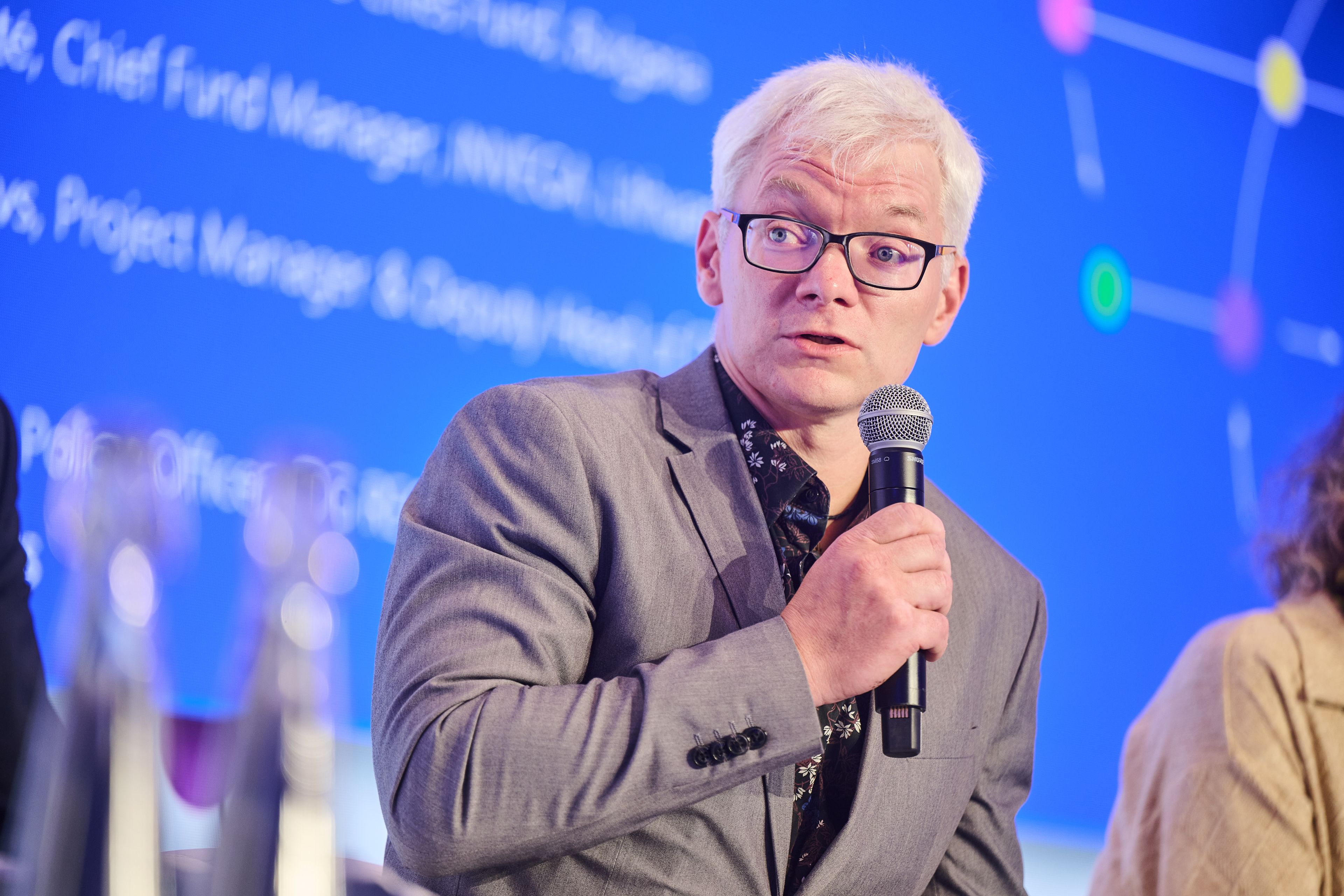A conversation with Aleksejs Kaņējevs, ALTUM, on the energy efficiency programmes for multi-apartment buildings in Latvia.

Aleksejs Kaņējevs, Deputy Head of Programme Development at ALTUM, the national promotional institution of Latvia.
1. Baltic countries have the highest share of people living in multi-apartment residential buildings in the EU, many of which stemmed from the Soviet era. Can you describe the housing situation in Latvia today and explain why it is important to invest in energy efficiency retrofitting?
We have 23 500 multi-apartment residential buildings which need renovation in Latvia. So, the demand for such support is indeed huge. We have calculated that overall, more than EUR 5.4 billion is required to finance and renovate these buildings. These renovations were supported through Latvia’s ‘Energy Efficiency Programme for Multi-apartment Buildings 2016-2023’ using 2014-2020 ERDF resources and now continue through the successor ‘Energy Efficiency Programme for Multi-apartment Buildings 2022-2026’ programme using RRF resources.
Now, every apartment owner has their own motivations to undertake energy efficiency retrofitting. For some apartment owners, the key factor is to increase comfort in the apartment, while others consider a subsequent increase in property value. Fewer and fewer apartment owners see energy retrofitting as a tool to lower their energy bills and this is mostly because renovation costs are gradually increasing. Nevertheless, retrofitting multi-apartment residential buildings extends the lifespan of buildings and significantly reduces energy consumption, which is essential given Latvia’s long heating season.
Public financing provides an opportunity to significantly reduce the costs of retrofitting works. There is a constant demand for public funding in this area. Reaching consensus from apartment owners on retrofitting relatively large buildings can sometimes be a challenge. Thus, we must adapt our support programmes accordingly. The condition of multi-apartment residential buildings will only deteriorate in the future. Thus, we encourage apartment owners to proceed with investments in a timely manner. This is a win-win situation for all parties.
2. fi-compass recently published a case study illustrating how the combination of financial instruments and grants support energy efficiency projects of multi-apartment buildings in Latvia. Could you please explain the reason why the programme includes two financial instruments: a guarantee and a loan instrument?
The model implemented in Latvia provides support through commercial banks. In this case, commercial banks have access to a loan guarantee from ALTUM. A guarantee is an important financial instrument to reduce lending risks, especially in cases where the loan is long-term, for example where it is provided for 20 years. In addition to loans provided by commercial banks, promotional loans can be directly provided to final recipients by ALTUM, too. We can see that, depending on the stage of the economic cycle, Altum's share varies from approximately 15% to 40% of the total loan amounts granted. Altum’s role is to supplement the market funding. Thus, these two financial instruments – loan guarantees and direct loans – provide greater flexibility in terms of implementation of the support measure and allow for a broader reach of customers.

Aleksejs Kaņējevs, Deputy Head of Programme Development at ALTUM, shared his experience at the recent fi-campus event in Brussels.
3. How are grants essential to the successful implementation of the programme? Could you also briefly explain how banks are involved in the management of the grant component?
Grants are essential to the programme's success because they reduce the payback period of projects. Our experience shows that without grants, the payback period of projects would be around 40 years, or even more. For many apartment owners, such a long payback period is unacceptable, and they would refuse to implement the respective investment projects. Thanks to the grant element, the payback period of projects is reduced substantially. As a result, apartment owners can agree on the implementation of the project.
It is important to design financial instruments that limit the need for banks to perform additional, non-standard functions, as this makes the loan product more expensive for apartment owners.
4. The case study focuses on lessons learnt from the renovation programme co-financed with European Regional Development Fund (ERDF) resources from the 2014-2020 programming period. The new programme, currently available to final recipients, uses Recovery and Resilience Facility (RRF) resources, ensuring no disruption of support to final recipients.
What are the key differences in the RRF-backed programme, if any? Once the RRF’s eligibility period finishes, do you plan to use 2021-2027 ERDF resources to continue the programme?
Within the framework of the European Regional Development Fund for the period 2014-2020, the grant elements were combined with both the guarantee and loan financial instruments in two separate operations. This meant twice the work on all sides – two applications, two decisions, and separate reports for grant and financial instruments. As part of the Resilience and Recovery Framework instrument, Altum switched to providing support in the form of a combined financial instrument – a direct loan with a capital rebate, namely a grant component or an individual loan guarantee and a capital rebate. The regulatory acts stipulate that the capital rebate is activated if the relevant renovation works have been completed and planned energy efficiency achievable based on respective calculations.
The capital rebate is used as a partial repayment of the loan principal. Such an approach provides financial institutions with easier adaptation to the implementation of support programmes. After the allocation of all available public funding, it is planned that support will be provided from the resources of the ERDF for the period 2021-2027. We plan that there will be a seamless transition from one funding measure to another.

5. The ‘one-stop-shop’ approach has also been instrumental in the programme's success. Could you explain how it works and what are its main benefits?
The Ministry of Economy proposed to create a one-stop service model in 2014, and in 2016 the Cabinet of Ministers approved a new measure that we talked about previously.
The one-stop-shop enables this measure to be implemented more coherently. However, management of classic grant instruments are not typical for financial institutions such as Altum. So, the first years of the programme’s implementation were quite challenging as the regulatory basis of grant instruments is different from financial instruments. The changes in the Common Provisions Regulation enabled us to apply a combined financial instrument model. In this case of combination in one operation, the rules for the financial instrument also apply to the grant component. This provides more flexibility and streamlines processes.

6. Could you also say a few words about the implementation of the programmes on the ground, what the demand has been like (how many buildings were renovated, how many households benefited from the programme). What main challenges did you encounter, if any, and how did you resolve these?
Within the framework of the ERDF for the period 2014-2020, total public funding of EUR 201 million was made available. The total number of renovated multi-apartment residential buildings with improved energy efficiency was 624 and the number of apartments (households) in the renovated buildings came to almost 22 000. The average decrease in energy consumption for heating was 60% and annual CO₂ savings reached more than 24 000 tonnes of CO₂ equivalent.
Under Recovery and Resilience Facility (RRF), a further 166 project applications have already been received and all available funding has been reserved.
Renovation projects require extensive documentation, which is a great challenge for apartment owners. To streamline the process, ALTUM provided support through consultations and gradually simplified the procedures applied to evaluate the projects. ALTUM also promoted public awareness by organising information campaigns and explaining the long-term benefits of retrofitting.
7. You are participating in fi-compass’s recently launched Scale-up initiative and presented your experiences in the fi-compass meeting on 25-26 September 2024 in Brussels. What are your key insights from this initiative and how does it benefit its members?
It is a great privilege to participate in such an initiative. It is an opportunity to share our knowledge and learn from experienced partners from different Member States implementing ERDF financial instruments in energy efficiency. It is also a great opportunity to find out about the latest developments and interact with experts from DG REGIO and the EIB. Our goal is to streamline processes to provide better services and increase uptake of energy efficiency financial instruments. Although each country has its own specific nature, the exchange of information provides an opportunity to better prepare for future challenges. As part of the initiative, we plan to prepare examples of standard documentation, which can be used in the future for similar measures. I particularly enjoy expanding the ideas linked to better use of combined financial instruments in the future.

Insights from Ruta Bite, Member of the Board of the apartment owners’ association “Institūta 10 Sigulda”

"After insulating the multi-apartment residential building at 10 Institūta in Sigulda, the heat energy costs decreased noticeably. We are glad that the apartment owners can now regulate their heat energy consumption. Comfort and visual appearance grew, and the market value of apartments also increased. We are very satisfied with the results achieved."
The Institūta 10 Sigulda apartment blocks
Constructed in 1979, Total area: 4 618 m2
Total project cost: approximately EUR 778 000
Before

The multi-apartments building located at Instituta street 10 in Sigulda prior renovation works.
After

The apartment building at Institūta Street 10, Sigulda after renovation was awarded “the most energy-efficient renovated apartment building in Latvia" in 2019.
The investment received 50% of the total project cost as a grant, while the remaining part was covered by the loan from one of the participating commercial banks, guaranteed by Altum at a guarantee rate of 80%. With an average cost of EUR 170 per square metre, the project achieved remarkable results.
As part of the renovation project, the basement cover was insulated, windows and exterior doors were replaced, the attic cover, facade and plinth were insulated, inflow valves were installed, the heating, cold and hot water systems were rebuilt, and lightning protection was installed. This led to a significant 71% reduction in heat energy consumption, cutting heat consumption from 159 kWh/m2 per year to just 45.63 kWh/m2 per year.
After the restoration measures, the building obtained B energy class. This substantial improvement not only enhanced the building's energy efficiency but also considerably reduced operating costs (cost saving amounts to EUR 5.80 per square metre per year after renovation). Additionally, the project achieved a reduced payback period, making it more attractive for both property owners and financial institutions.
Source: Altum



